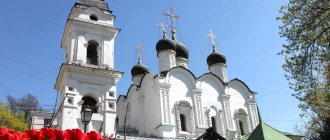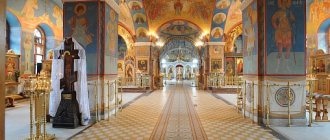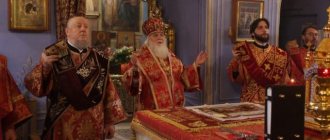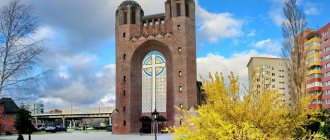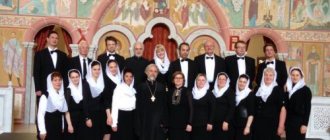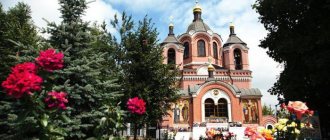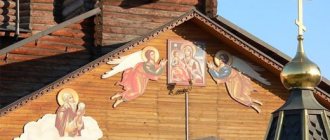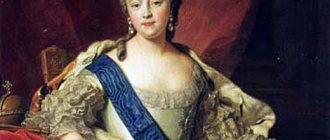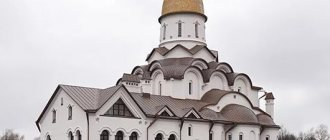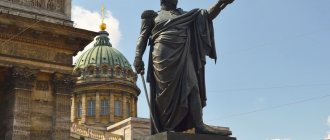| Moscow Church of the Exaltation of the Holy Cross, on Vozdvizhenka, in the former Holy Cross Monastery |
Moscow Church in honor of the Exaltation of the Honest Life-Giving Cross of the Lord, on Vozdvizhenka
(inactive, demolished in 1934)
- Address: Russia, Moscow, st. Vozdvizhenka, vacant lot behind 7
- On the map: Yandex.Map, Google map
Founded in the 16th century.
Until 1814, the church was the cathedral church of the Holy Cross Monastery. After the capture of the Cathedral of Christ the Savior by renovationists, the Church of the Exaltation was for some time the Patriarchal and Moscow Cathedral.
History of the parish
The Church of the Exaltation of the Cross was built at the same time as the New Jerusalem Monastery. In the XVIII century. Patriarch Nikon planned to create a semblance of the Holy Land on Istra land. The surrounding hills and rivers received new biblical names - Tabor, Hebron and Kidron, and the village of Darna was renamed Vozdvizhenskoye. The village received this name because its geographical location is approximately where the Monastery of the Holy Cross was founded in Jerusalem.
The Church in honor of the Exaltation of the Holy Cross was founded in 1686. Initially it was built of wood - unfortunately, no information about its fate has been preserved, but in the middle of the 18th century. a parish was built here in honor of the apostles Peter and Paul.
In 1895, the parishioners’ request to erect a stone church on the territory was fulfilled. In the same year, the foundation of the future parish was laid, and five years later, in 1900, the new three-altar church was consecrated. From that time on, services began to be held here. There was a parochial school here and a small brick factory.
The quiet and peaceful life of the believing villagers continued until the revolutionary events of 1917, and after that the period of militant atheism began. In 1937, the temple in Darna was closed, the bronze bells were removed and taken away for melting down “in favor” of industrialization, the property was confiscated, and the building was used for other purposes.
When the Great Patriotic War began, German troops occupied Darna. They mercilessly burned village houses and other buildings. The wooden church of Peter and Paul burned down, but the stone church survived. The bell tower was badly damaged; a hit shell demolished the upper tier with the tent. In the post-war period, the Church of the Exaltation of the Cross was used as a forge, a repair shop and a warehouse for mineral fertilizers.
Story
The temple on Chisty Vrazhek received its second name from the place on which it was built. In tsarist times, manure from the royal stables was removed to a ravine located not far from the church, and therefore it was called Pomyotny. Later it was cleaned out, and it received a new name - Pure Enemy.
In the 16th century, a wooden church stood on the site of the stone temple. When it fell into disrepair, it was demolished and construction began on a new building made of stone. Work on the construction of the church lasted 18 years: from 1640 to 1658. The temple was consecrated in honor of the Exaltation of the Holy Cross.
The church did not stand in its original appearance for long. In 1701, Prince Sheremetyev, a close associate of Peter I, decided to serve the Lord and, with the permission of the Tsar, significantly changed the appearance of the building. Initially, the temple had a two-story quadrangle, to which a semicircular apse and a refectory were attached. After reconstruction, only some walls remained the same in the building. In 1708, an additional chapel was added to the north side of the temple, topped with a dome with a cross. It was consecrated in the name of the “Mother of God.”
The reconstruction of the building did not end there. From 1761 to 1782, significant changes again occurred in the appearance of the church. The refectory and northern chapel were expanded, and the altar was enlarged. New walls were built next to the old brickwork from the 17th century, thanks to which it has survived to this day. In 1798, a large hexagonal drum was built on the main building of the temple and the decor of the building was updated.
After the monstrous invasion of Napoleonic troops, the Church of the Exaltation of the Holy Cross, among other churches in Moscow, was significantly damaged by fire. Local parishioners quickly raised funds and restored the burned-out building. In 1813 its consecration took place.
In 1846, the deceased merchant G.I. Blokhin left a significant amount to the temple. With this money, it was decided to build a low bell tower with a spire on the western side. The missing amount was donated by the local manufacturer Ganeshin. There was also enough money to arrange a second chapel in the name of Arch-La Gabriel in the refectory. The consecration of the bell tower took place on September 8, 1852.
In the 19th century, the Church of the Exaltation was surrounded by a fence made of white stone. Its granite base on the side of the ravine was very high and resembled a fortress. In 1887, local merchant I. S. Vinogradov began to fear that the church building, located on the edge of a ravine, might begin to slide and collapse over time. Using his own funds, the ktitor strengthened the embankment by building a stone wall to hold the soil.
At the end of the 19th century, the last reconstruction of the building was carried out. According to the design of architect F.N. Kolbe, a southern and northern aisle was built on both sides of the main altar. On October 24, 1895, their consecration took place.
In tsarist times, most of the parishioners were soldiers, servants of the royal court and working people. But among the flock there were also families of noble origin, for example the Dolgorukys and the Musins-Pushkins. On May 25, 1901, the wedding of the writer A.P. Chekhov took place in the church.
By 1918, the Church of the Exaltation of the Holy Cross, thanks to the patronage of merchants, became one of the richest churches in Moscow. After the revolution, the temple was barbarically plundered by the Bolsheviks. Vandals took away more than four hundred pounds of ancient silver utensils.
In 1930, the church was closed and a dormitory was installed in the building. The abbot Nikolai Saryevsky was arrested and sent to a camp. The parable house and almshouse were demolished, the bell tower and domes were broken. The interior wall paintings were painted over with whitewash. When she appeared, she was simply shot down. Fortunately, 70% of the drawings survived.
In 1992, the temple was returned to the Moscow Diocese. On April 8, the first prayer service took place near the church fence. Since November, all-night vigils began to be held regularly in the southern aisle. Restoration work to restore the dilapidated building lasted 18 years and ended at the end of 2000. The temple acquired its former appearance thanks to the preserved design of the architect F. N. Kolbe.
The house temple at the surgery center is assigned to the temple on Chisty Vrazhek. Divine liturgies are held twice a week.
Revival of the Church
Spiritual life in Darna began to revive in 1991. Then a small Orthodox community was organized here, consisting of local grandmothers. Father Konstantin (Volkov) was appointed rector.
Father knew that the cathedral in the village. Darna needs to be restored, but when I arrived at the site, I did not expect to see a dilapidated structure. There were no domes on the roof of the church; instead, two-meter-tall birch trees and moss grew; two tiers of the belfry remained; the area was overgrown with bushes. But this did not frighten the former Afghan warrior (Fr. Konstantin served in Afghanistan), his father inspired and encouraged the believers, saying that everything would work out and the temple would be restored to its former beauty.
The first work to clear the complex of debris was carried out by the priest and the elderly women of the village, but then men got involved, and then specialists - builders, restorers... The local church began to be transformed.
As soon as the rubble inside was cleared, services began. In 1997, tents with domes rose above the temple, in the same year the bell tower was completed and the bells were raised, and then interior work began. In 2001, the consecration of the rebuilt temple building took place.
Architecture of the Church of the Exaltation of the Cross
The Holy Cross Church in the village of Darna was built according to the design of the Moscow architect S.V. Sherwood. The restoration project (1991) was developed by the architect-restorer M. Yu Goryacheva.
The church was built in an eclectic style, the main emphasis is on the decorative decoration of the facades made in facing brickwork: kokoshniks, panels, cornices, decorative belts, stepped arches. All this sends visitors to the traditions of Russian architecture of the 17th century (Moscow patterns).
The quadrangle is crowned by a large octagonal light drum with an onion dome - the central chapter, and four smaller chapters are located in the corners. On the western side of the church there is a three-tier bell tower and a hipped porch. On its second tier there are life-size mosaic icons of saints.
There was a beautiful painting inside the temple, unfortunately, it was “erased” by time and the ignorance of the people in power, who turned the building into a warehouse. During the restoration of the interior decoration, restoration artists from the Kitezh creative workshop decorated the walls and arches with stucco. Carved wooden iconostases were also made to match the patterns.
Orthodox Life
The author of the famous novels “The White Guard” and “The Master and Margarita” received the Sacrament of Baptism in the lower St. Michael’s Church on May 8, 1891.
Church of the Exaltation of the Cross. Chapel of St. Nicholas the Wonderworker. View from the north
The Church of the Exaltation of the Cross is located on the outskirts of old Podol - one of the oldest districts of Kyiv. The church, located under Castle Hill, blends harmoniously into the natural landscape of the area. Near the temple there are historical places of ancient Kyiv, the names of which are reminiscent of the life that was in full swing here in the old days. Zhitny Bazaar is located on the site of the ancient Zhitny market, known since the 11th century. The Kozhemyaki and Gonchary tracts adjacent to the church from the 11th–12th centuries. were inhabited by artisans. According to folk legend, in time immemorial the hero Kirill Kozhemyaka settled here, defeated the cannibal snake and rescued the daughter of the Kyiv prince.
After the devastation of the Upper City in 1240 by the nomadic hordes of Khan Batu, the life of Kyiv throughout the 13th–18th centuries. focused on Podol. Kozhemyatskaya settlement was inhabited by leather craftsmen who had their own craft workshop. As a corporate member he was a member of the Kiev Orthodox Brotherhood, founded in 1615, during the Polish-Lithuanian Commonwealth, to defend the Orthodox faith. Residents of the significantly grown settlement, assigned to the remote Vasilievskaya Church, asked permission from the spiritual authorities to build a temple at their own expense. So in the middle of the 18th century, Kozhemyaki had its own parish church. Her parish was inhabited mainly by simple Podolsk townspeople - traders and artisans. The parishioners of the Church of the Exaltation of the Cross could well have been the characters in the famous comedy “For Two Hares” - a revised play by I. Nechuy-Levitsky “On Kozhemyaki” (1).
Currently, there are almost no residential buildings left near the Church of the Exaltation of the Cross, and its parishioners travel to services from afar. The old estate buildings of the Kozhemyaki, Gonchary, and Degtyari tracts were completely destroyed in the late 1990s. On the site of the resulting wasteland, an elite town called “Vozdvizhenka” was built, the mansions of which remain uninhabited. Pretentious and bulky buildings have distorted the appearance of the ancient tracts of Podol, but their names still attract people as repositories of the memory of the past. The Church of the Exaltation of the Cross remains a witness to the history of these places - the last old resident of Kozhemyak, located at the end of the Upper Val, at the address: st. Vozdvyzhenskaya, 1.
The first wooden church, the predecessor of the current temple, appeared on Kozhemyaki in 1748. It so happened that it became a “relative” of St. Andrew’s Church, built by order of Empress Elizabeth Petrovna. In 1744, the ceremonial foundation of a stone church took place on the mountain, where, according to legend, St. Apostle Andrew erected a cross. The name of the dismantled wooden Vozdvizhenskaya Church with St. Andrew's chapel that stood there passed on to the church that appeared on Kozhemyaki in 1748. Inventories of the Kyiv governorship of the 1780s. indicate that the church was built by the kosht of the Kyiv tradesman Artem Trofimovich Kozhemyaki.
A small three-domed wooden church in a stone fence burned down during the fire of 1811, which destroyed almost all the buildings of Podol. At the same time, a stone church was laid on Kozhemyaki, the construction of which, with significant time intervals, took more than 80 years - from 1812 to 1905. As a result, the Church of the Exaltation of the Cross, which changed its architectural and artistic appearance over the course of a century, became an original monument of church architecture of the 19th – early 20th centuries. A staircase leading to a high open porch platform is attached to the two-tier building of the temple with a bell tower. Thus, in accordance with tradition, the church throne in the name of the Exaltation of the Holy Cross was built on an elevated place.
The historical event of the Exaltation of the Cross, which took place in 325 in Jerusalem, is depicted in the southern aisle at the entrance to the temple. In the center of the pictorial composition is the Cross of the Lord, erected by the Jerusalem Patriarch Macarius. Below there is a panorama of Jerusalem, above which there is a high sky, illuminated by reflections of the sun. To the left of the Cross is the kneeling St. Queen Helena, who found the Honest and Life-Giving Cross. Around are clergy and residents of Jerusalem, symbolizing all Christians who worship the Cross.
On the patronal feast of the Church of the Exaltation of the Cross (September 27, September 14 - old style), the rite of raising the Cross is performed in this Podolsk church. From the altar comes the Crucifix - the shrine of the temple with a particle of the Holy Cross. With the repeated singing of “Lord have mercy,” the Cross is raised for viewing by all those praying, as was the case during the ancient erection in Jerusalem.
The lower church with the chapel of St. Archangel Michael (1812) became the initial core of the church building, to which new volumes were gradually added (2). The design of the upper tier of the Church of the Exaltation of the Cross with a bell tower was drawn up in 1822 by the Kyiv city architect Andrei Ivanovich Melensky (1766–1833), who led the restoration of the post-fire Podol. The architect fit into the hilly landscape of Kyiv small “dotted” churches with rounded shapes, marked by beauty and grace. The characteristic features of the style of A.I. Melensky are noticeable if you look at the Church of the Exaltation of the Cross from the eastern altar side. The upper church, built in 1839 after the death of the architect, was consecrated in 1841 by the Kyiv Metropolitan, St. Philaret (Amphitheater).
Altar apse of the temple
Melensky's original plan was completed by the construction of the bell tower in 1859–1860. under the leadership of the diocesan architect Pavel Ivanovich Sparro. In photographs of the second half of the 19th century. captured the view of the Church of the Exaltation of the Cross - a rectangular building with one dome. From the east it ended with a semicircular altar apse, from the west - a bell tower with open spans and a dome with a high spire. In the early 1880s. The territory of the church estate was landscaped and a stone fence appeared around it.
Over time, the Church of the Exaltation of the Cross became too crowded for the increasing number of parishioners. The temple expanded significantly after reconstruction in 1886–1887. under the leadership of the diocesan architect V. N. Nikolaev (1847–1911). On the south side, a large stone extension was made - an upper aisle with the entrance to the temple, and below it - a semi-basement floor. The paintings carried out during the work of the 1880s have been preserved on the walls and vaults of the central part of the temple.
The final stage in the history of the Church of the Exaltation of the Cross was the work of the early twentieth century, also carried out under the leadership of V.N. Nikolaev. In 1901–1905 a two-story extension was added to the north symmetrically to the south. On its top floor there is a chapel in honor of the Kazan Icon of the Mother of God. The upper side aisles of the church were decorated with paintings in 1914–1915. under an agreement concluded with the church painting contractor L.F. Kokhno. Many of the compositions in the southern and Kazan aisles were made by the bright and original Ukrainian artist G. P. Svetlitsky.
View of Podol. In the lower left corner is the Holy Cross Church. Pre-revolutionary photo
The clergy assigned to it lived next to the temple. A two-story house for the clergy of the church, with its front facing Vozdvizhenskaya Street and its end facing the church yard, was erected in 1910–1912. The last construction of 1914 was a tented chapel in honor of St. St. Nicholas the Wonderworker (architect Alexey Petrenko), the name of which indicates the icon of St. Nicholas, a quick helper and intercessor, located there.
The October Revolution of 1917, which became the beginning of the Soviet period of our history, opened a sad page in the annals of the Podolsk church. In 1917, the priest Fr. Theodosius Pavlovsky, who was destined to become its last abbot. Late 1920s – early 1930s. - a time of mass closures and destruction of churches, arrests and executions of clergy. Divine services in the Church of the Exaltation of the Cross were stopped in 1935, and workshops and a warehouse were set up here. After the closure of the temple, its rector, Fr. Theodosius Pavlovsky was exiled to Siberia. The only functioning church in Kyiv before the start of the Great Patriotic War was the Holy Ascension Church on Demievka.
During the period of Nazi occupation 1941–1943. Divine services resumed in the Church of the Exaltation of the Cross. Fr. was again appointed rector. Theodosius Pavlovsky. In January 1948, the “Journal of the Moscow Patriarchate” published an obituary for the shepherd: “On November 3, 1947, in the 87th year of his life and 62nd year of pastoral service, the oldest and most honored clergyman of the Kiev Metropolis, rector of the Kiev-Podolsk Holy Cross, died. Vozdvizhenskaya Church protopresbyter Fr. Theodosius Pavlovsky."
Church of the Exaltation of the Cross in 1944
After a new wave of Khrushchev’s repressions against the Church in Kyiv, by the end of 1961, only 8 out of 25 operating churches remained. The clergy of the closed Church of the Intercession in Podol was transferred to the Church of the Exaltation of the Cross, where services did not stop. Its rector, the famous pastor Fr. Alexy Glagolev became the second priest of the temple. There is interesting evidence in the memoirs of L. Ya. Yaskevich, one of the oldest Kyiv parishioners: “Then three parishes united in this church: the Exaltation of the Cross proper, our Pokrovskaya and Ukrainian-speaking (not autocephalous). It is noteworthy that when Fr. fell ill. Alexy Palivoda is a priest of the Ukrainian parish, Fr. Alexy Glagolev performed the service in Church Slavonic (he was weak in the Ukrainian language), and the choir sang, and the reader read in Ukrainian, and, despite the diversity of languages, everyone was happy, everyone was in the peace and love of Christ. There was no confrontation then” (3). In the history of the temple, dating back to the twentieth century, there remain many blank pages that, perhaps, will be filled in over time.
Since the second half of the 1980s. It became possible to carry out repair and restoration work in churches (which was previously practically prohibited by the Soviet authorities). In 1986–1988 In the upper tier of the Church of the Exaltation of the Cross, wall paintings were renewed using community funds. In 1991, the lower church of St. Archangel Michael. In 2000, through the diligence of the rector, Archpriest Andrei (Pechnik), the chapel of St. was built and painted below. Apostle Andrew the First-Called. Thus, the original connection between the Holy Cross Church and St. Andrew's Church was restored. A new iconostasis was installed in the upper church, made by craftsmen from Ivano-Frankivsk. The current rector of the Church of the Exaltation of the Cross, Fr. Andrey (Pechnik), who celebrated his 90th birthday last year, is the oldest clergyman of the Kyiv Metropolis. For more than 70 years he has been performing his priestly ministry, 22 of them in the Church of the Exaltation of the Cross.
O. Andrey (Pechnik)
Over the more than 200-year history of the church on Kozhemyaki, many people have been associated with it - clergy, architects and artists, builders and craftsmen, and its parishioners. Among the names that have gone down in history, one should name the writer Mikhail Afanasyevich Bulgakov (1891–1940), author of the famous novels “The White Guard” and “The Master and Margarita”. On May 8, 1891, the future writer received the Sacrament of Baptism in the lower St. Michael’s Church. The first years of his life were spent in a house on the street. Vozdvizhenskaya, 10-v, where his father, associate professor of the Kyiv Theological Academy, Archpriest Afanasy Bulgakov, rented an apartment from the then rector of the Church of the Exaltation of the Cross, Fr. Matthew Butovsky.
The famous Ukrainian artist, master of lyrical landscape, Grigory Petrovich Svetlitsky (1872–1948) lived most of his life near the Church of the Exaltation of the Cross. The artist decorated the walls of the temple, where he was baptized in infancy and later married, with his paintings in 1915. The life and work of G. P. Svetlitsky, like the entire ensemble of murals in the Church of the Exaltation of the Cross, is an interesting topic that deserves a separate story. With this we hope to continue our acquaintance with the Podolsk Church of the Exaltation of the Holy Cross.
senior researcher at the National Kiev-Pechersk Historical and Cultural Reserve Elena Lopukhina
Notes:
1. If we adhere to historical accuracy, then the final scene of the film should have taken place precisely on the stairs of the church on Kozhemyaki. 2. When writing the article, materials from the book by L. I were used. Tolochko, M. G. Degtyarov “Podilsky churches of Kiev.” K., 2003. 3. El. resource: https://www.kiev-orthodox.org/site/personalities/5059/
Temple shrines
Ancient icons and utensils, stored in the Church of the Exaltation of the Cross before the revolution, were confiscated in the 30s. Their further fate is unknown. After the revival, the church began to be replenished with new copies, among which there is a rare image of the Mother of God “Augustovskaya”. It depicts the appearance of the Mother of God to Russian soldiers near the Polish city of Augustow, which is why it received this name.
It was no accident that the image appeared here, because Fr. Konstantin served in Afghanistan in the past, and now serves in the church, conducts educational activities in military units, the State Traffic Safety Inspectorate, the Internal Affairs Directorate, spiritually cares for internationalist soldiers, and the families of fallen soldiers. The day of remembrance of the icon takes place on September 14. On holiday, military personnel come here not only from Istra, but also from other regions to pray with her.
Modernity of the temple
The restored Holy Cross Church is today again a place of attraction for pilgrims and tourists, who leave numerous reviews about it as a blessed corner. It is located near the New Jerusalem Monastery, together with it it is a historical and cultural heritage. But first of all, the Darna Church occupies an important place in the spiritual life of villagers and visiting people who felt God's grace here.
Internationalist soldiers, mothers and relatives of fallen soldiers traditionally gather in the Darna temple on the day of the withdrawal of Soviet troops from Afghanistan (February 15). Then a funeral litany is served, and then a joint meal is organized for all the guests. Here many find consolation and receive support from Fr. Konstantin.
In 2011, an apple orchard was planted on the territory in memory of those living and killed in 1979-1989 in Afghanistan. The village residents are proud of the church, which has been revived and is proudly called a landmark of the Istrinsky district. Muscovites, and not only them, strive to come here when the Exaltation of the Holy Cross is celebrated - a patronal holiday. In the church, like major church holidays, Victory Day is solemnly celebrated.
Church of the Exaltation of the Cross at the city gates
The beginning of one of the most ancient cities of Russia - Mozhaisk - was laid by an ancient wooden fortress located on a high hill, which later received the name Cathedral Mountain. First mentioned in chronicles in 1231, it was undoubtedly built much earlier than this date. Over time, towns and settlements grew around it, and a city was formed. In sources of the XV-XVI centuries. we find references to the same wooden fortress, but with white-stone travel gates and a white-stone gate church above them. The church that is on the large city gates is called differently in different acts: the Exaltation of the Honest and Life-Giving Cross of the Lord, the Exaltation of the Cross, or simply the Exaltation of the Holy Cross, “which is on the city gates.” On the battle ground in front of the church, a chapel was built in the name of St. Nicholas of Mozhaisk, which, in fact, was a chapel that had neither an altar, nor a throne, nor an altar. It was in this chapel-chapel that the famous miraculous icon of St. Nicholas of Mozhaisk was kept - a wooden carved figure with a sword in one hand and a fortress with a temple in the other. The fortress gates with two gate churches, radically rebuilt in subsequent centuries, are unique in that through a series of further reconstructions they turned into the St. Nicholas Church, which then became the main city cathedral. Not a single city cathedral in Rus' had such an amazing transformation. The existence of a gate temple in itself is not an out of the ordinary fact; from the very beginning of the appearance of monumental architecture in Rus', we have encountered buildings of this kind. Their peculiarity, inherent in the name itself, is their location: usually such temples were built above the gates of fortresses, kremlins and monasteries. But the gate white-stone Church of the Exaltation of the Holy Cross above the main passage gate with the side church-chapel of St. St. Nicholas of Mozhaisky on the battle tower is a rare structure of ancient Russian religious architecture. In terms of architectural merits, it stands on a par with such famous monuments as the Golden Gate with the Church of the Annunciation in Kyiv, dated c. 1037, and the Golden Gate with the Church of the Deposition of the Robe, erected in 1164 in Vladimir. The Mozhaisk Gate was almost as large as it was, but differed in that it housed two churches at once. Today there are two versions about the time of construction of the white stone gates and the foundation of the temple on them. The first was put forward by art historian T.G. Gorbachevskaya during the restoration of St. Nicholas Cathedral in 1983. In her “Historical Note” she dates the Mozhaisk fortress to the first half of the 15th century, and dates the construction of the gate and gate temple to 1541. It is clear that this date was taken on the basis of the inscription on the foundation stone in the wall of the Old St. Nicholas Cathedral, which says: “in the summer of 7049 (1541) the porch was built, and the city was built in the same summer.” We read about the second version in the book by G.Ya. Makeev “Mozhaisk - the sacred city of Russians”, where he dates the construction of the gates and the church on them to 1470, during the reign of Yuri Vasilyevich, Prince of Dmitrov and Mozhaisk. However, from historical sources it follows that during the short period of his reign (1462-72), Prince Yuri Dmitrovsky did not even build a single stone church in his capital Dmitrov, not to mention other cities under his control. It is also unlikely that the gate church was built in 1541, because in the middle of the 16th century, white stone construction was practically no longer carried out in Rus' and was replaced by brick. The most plausible assumption seems to be that the gates and church are among those built during the reign of the prince of Uglich and Mozhaisk Andrei Vasilyevich Bolshoi in 1481-93. On the lands under his control, Prince Andrei in the 70-90s. XV century develops extensive stone construction, which directly indicates his special interest in architecture (this topic is worthy of more detailed consideration and will be covered in the next issue of the magazine). The earliest mention of the Vozdvizhenskaya Church dates back to 1536 in the Charter of Ivan the Terrible, with the mention of Vozdvizhensky priest Dmitry Ivanovich, son of Trubitsyn. We can get a more detailed description from the Scribe Book of 1596-98: “The town of Mozhaesk on the river on the Mozhai, made of wood, was covered with clay, the wall was whitewashed, and the roof in the city rotted. In the city there is the cathedral church of St. Nicholas the Wonderworker of Mozhaisk and the chapel of the torment. Christ's George. Yes, on the large stone gate is the Church of the Exaltation of the Holy Cross. ...Yes, on the gate at the Exaltation of the Honest Cross in the chapel there is a miraculous image of St. Nicholas the Wonderworker standing on a rezi in an icon case with an act, the icon case is overlaid with silver, the crowns and fields are gilded; St. Nicholas the Wonderworker has a hammered gold crown, and in the crown there are five golden burrs, in the upper burr there is a green emerald stone, on the sides in the burrs there are two worm-like lalas, and in the lower burr there is a green emerald stone, and on the other side the green stone is bad, but in the burrs four pearls each, and Nikola the Wonderworker has a sword in his right hand, and in his left hand the city of Mozhaesk is overlaid with Basmian silver and gilded.” The following describes the rich precious “butt” placed on the carved figure of Nikola: ... tsat of gold, and in it the stone Yakhont Lazorev ... yes tsat of gold, yes 10 tsat of silver basmyany gilded with a stone ... 2 tsat of silver gilded; ... yes 325 hryvnia of silver; yes 21 hryvnia with pearls.” The statue’s precious attire, especially the golden tsats on Nikola’s neck, testified to the great veneration of the image - they were given in gratitude to the saint for his numerous miracles and healings.
There is little information about the appearance of this temple, but we can read some information in the Notes of Kaspar Savitsky, who visited Mozhaisk in 1606 as part of the retinue of Marina Mnishek. Father Savitsky, who accompanied her, left interesting diary entries regarding this visit: “On May 2, the princess (Marina Mnishek) arrived in Mozhaisk, in the town of the Moscow state, a city famous for the icon of St. Nicholas, carved work. Mnishek wanted to look at the Russian shrine, and we went to the fortress to the icon of St. Nicholas. The fortress is located at the very end of the city and is surrounded on all sides by a moat, rampart and wall. At the entrance it has a stone gate, above which, in the inner part of the fortress, on the left side a stone staircase leads through a vestibule and a dark corridor to the chapel of St. Nicholas. When we arrived there, we were allowed into the chapel itself, on the left side of which there is another, smaller chapel, separated on both sides by a special wall and everywhere richly decorated with beautiful pictures representing the miracles of St. Nicholas. In the middle there was an icon of St. Nicholas in full height, carved from wood and yellow in color: either because it is already a tree, or because the tree is painted with yellow paint, or because of old age. The icon features silk vestments similar to those worn by Greek priests during services. The robe up to the waist is decorated with gold and silver plates depicting various parts of the body: arms, legs, heart, etc., brought in gratitude for the healings received by those people whom God heard, prayers for the sake of St. Nicholas. In the right hand of St. Nikolai holds a sword, and his face expresses more severity than kindness. All Russians highly reverence this icon and often come to venerate it. No one is allowed into the shrine with weapons. And when I entered (says Savitsky) with only one dagger, the archpriest, who had supervision over the shrine, snatched the dagger from my hands, threw it on the ground, and ordered it to be taken out the door so that the sanctity of the place would not be violated. Having examined everything, we thanked the keeper for his helpfulness, which he showed to us, strangers, by showing us such a glorious icon of this Saint. Then we went to the fortress and entered one beautiful stone temple, located almost in the very middle of the fortress. There, on the right side of the temple we saw another image of St. Nicholas “Peaceful”, also in full height and carved, only smaller than the first. He stood against the wall, was covered with vestments and decorated with gold and silver, and in his right hand he held an orb made of silver. When we asked why the first icon holds a sword in its hand, and the other an orb, we were told that the first icon is worshiped mainly during war, and the second during peace.” At the beginning of the 17th century, the city found itself at the center of the Polish-Lithuanian invasion. During the Time of Troubles, during the Lithuanian devastation, the fortress gates were badly damaged. In 1617, the army of Prince Vladislav, marching towards Moscow, was stuck for 8 long months at the Mozhaisk fortress. Their artillery was posted on Brykina Hill, from which part of the courtyard was visible. In the summer of 1618, daily shelling of the city began. During the next assault on the fortress, one of the shells hit the government powder tent at the Nikolsky Gate: the exploding gunpowder warehouse collapsed the inside of the stone gate and the Vozdvizhenskaya Church standing on it. Only the altar and the side chapel of St. Nicholas survived. Despite frequent shelling and severe destruction, the defenders of the fortress, courageously repelling all the assaults of the Poles, held out and did not surrender the city. By the fall of 1618, having failed in Mozhaisk, Vladislav decided to march on Moscow, but, having learned that Pozharsky and Minin had already assembled a new militia by that time, Vladislav had no choice but to conclude a truce, which went down in history as the “Deulinskoe”. The terms of the agreement were reduced to 17 points. Point number 12 contained the condition “on the return of the image of St. stolen in Mozhaisk.” Nicholas and the ambassadors Filaret, Prince Golitsyn, clerk Tomila Lugovsky and others detained in Poland.” The return of the icon of St. Nicholas of Mozhaisk was set as one of the conditions for the truce! On June 10, 1619, near Mozhaisk, an honorary meeting was held for Metropolitan of Rostov Philaret (father of Tsar Mikhail Fedorovich), released from eight years of Polish captivity. In Mozhaisk he was met by Archbishop Joseph of Ryazan, Prince Dmitry Mikhailovich Pozharsky and okolnichy Grigory Konstantinovich Volkonsky with a retinue of clergy and secular persons. “In the same year 7127 (1619) the image of the great wonderworker Nikola, who was also at the Gate, was brought from Lithuania to Mozhaesk.” This meeting is depicted in miniature in the book “The Election of Mikhail Fedorovich to the Tsardom.” On it you can see a passage gate with a chapel and a church, but the picture does not show signs of destruction from the explosion. The depicted church is similar to the one that stood before 1684 - three-domed, cross-domed, made of white stone blocks, with the facade divided by blades into four spindles with an icon case in the middle semicircle and narrow lancet windows, under the icon case there is a decorative belt along all the walls, ending with mosquitoes. Here, again, it is necessary to emphasize that such architectural and structural features are more consistent with the forms characteristic of the 15th century, with the style of buildings during the reign of Andrei Uglichsky. In the 20s of the 17th century, the chapel was repaired and consecrated as a separate temple, and the Mozhaisk shrine was placed in its original place. In 1624, according to the Sovereign's charter, the repair of external damage caused to the fortress during the invasion of the Poles began. The Nikolsky Gate and the temple were also restored. By 1626, the entire Mozhaisk fortress became stone and brick. Upon completion of construction in 1626, governors I.V. Izmailov and B.M. Lykov compiled two inventories of the work done. The first “Masonry Painting” described the walls and towers of the new stone fortress. The following is said about the gates: “Yes, at the Nikolsky Gate from inside the city, which was torn out by the gunpowder treasury during the Lithuanian devastation, and that place was again brought down with stones and bricks by the bulls and they made vaults, and laid bricks on top of the vaults with the Nikolskys that are on the gates, with church doors on the lower threshold exactly. Yes, at the same Nikolsky Gate, a tent was destroyed by the treasury of gunpowder, and that tent was made again with stone and brick.” The second inventory talked about repairing the old Nikolsky Gate and the two tents and walls adjacent to it. From the inventory you can see not only what the gate looked like after the repair, but also what it was like before the explosion: “The Nikolsky stone gate is an old thing; The Church of St. Nicholas the Wonderworker of Mozhaisk is an old work, but at the top of the Church of St. Nicholas the Wonderworker in the forehead and in the vaults and in the gates the bad places have been made new; Yes, to the same gate there are new additions on the old soil that was under the church under the Exaltation of the Honorable Cross on both sides and with bulls, the width and height opposite the old St. Nicholas Gate, stone vaults have been built up and paved with bricks along the church threshold of St. Nicholas the Wonderworker. And in those Nikolsky gates there are only wooden folding gates with a thin gate; and before the destruction there were two gates: one with a gate, and the other blind, and now it is necessary to make another gate. In the Nikolsky gate on the right, a stone tent under the altar of St. Nicholas the Wonderworker is an old thing, wooden doors on iron stands; in the tent there are 2 windows outside the city on a bridge without bars, and the 3rd outside the city on the scree with an iron grate, and the doors are thin iron, and now there is a green treasury in it. At the Nikolsky Gate in the city there are two stone tents: one to the right, and the other to the left. On the right side there is an old stone tent, wooden doors on iron posts. And in the back of the tent there is a stone box the width of the tent. On the left side there is a stone tent and a new thing on old soil. And in that new tent and in the old one, which is on the right of the gate, the green treasury is wise and cautious against the guard. And on top of those tents and the brick bridge near the Church of St. Nicholas the Wonderworker there is an old church Vozdvizhenskaya altar wall, a stone one, and on it there are two bell pillars, damaged from the church by a potion. And during a siege, people are needed to the Nikolsky Gate with a fiery battle, 50 people in one shift. Yes, only in the tent, which is under the altar of St. Nicholas the Wonderworker, there was no treasury or other supplies, and from that tent there would be a foot-to-foot battle, but 2 people would be needed at the window, for a total of 6 people.” From the painting of 1624-26. it is clear that only the gates were restored; corrections were made to the west (from the side of the explosion) and a new access staircase was erected to the battle platform to the chapel that stood on it. On the surviving altar wall of the Church of the Exaltation, a belfry with two pillars was installed and a messenger was hanged, i.e. alarm bell. In case of danger, he sounded the alarm, notifying residents of the city and surrounding areas about the impending threat. Information has also been preserved about the bells that hung on the bell tower; two of them were donated by the tsar. One had the inscription “Cast in the summer of 1636 at the behest of Tsar Mikhail Fedorovich,” and in 1643 the Tsar donated another bell weighing 223 pounds to St. Nicholas. The Church of the Exaltation itself was not restored; we do not find it in the list of the Mozhaisk governor Ivan Lavrentievich Shekhovsky. In his Census Book of 1629, he counts 21 empty church places and lists 9 surviving churches, not counting the monastery ones: St. Nicholas Cathedral with St. George's chapel, St. Nicholas on the gate, Preobrazhenskaya, Nikitskaya, Ilyinskaya, Uspenskaya, Pokrovskaya and Pyatnitskaya. According to the Watch Book of empty church quitrent lands of the patriarchal copyist Alexei Artemyev Rankov dated June 1668, Ivan Usov owns the lands belonging to the Vozdvizhenskaya Church, and pays quitrents 6 money. It should be noted here that Mozhaisk was already declared a Patriarchal volost in 1625 by a royal charter. Several patriarchal land audits were carried out in the city (in 1653, 1668, 1670, 1675 and 1689). These commissions strictly ensured that the former church lands were not settled by outsiders (they were expelled from the lands). Empty church lands were distributed among parishes. In the salary books of the Patriarchal Treasury Order, it was strictly noted how much tribute was collected from each plot, and who paid it.
But let's return to the story of reincarnation. On December 6, 1680, on the holiday of St. Nicholas the Winter, Tsar Fyodor Alekseevich visited Mozhaisk. The retinue also included Patriarch Joachim, for whom Mozhaisk was his hometown, and his ancestral estates were located in the district. It was then that it was decided to expand the gate temple. In 1681 they began to bring material to rebuild the new church. On March 14, 1683, Patriarch Joachim ordered the construction of a new church of St. St. Nicholas the Wonderworker, which is on the city gates. The following year, 1684, the new stone church was already built; all that remained was to erect the iconostasis. On July 31, Patriarch Joachim ordered the installation of an iconostasis, the same as in the Patriarchal Church of the Moscow Kremlin. Money in the amount of 421 rubles 25 altyns was allocated from the Treasury Order. Carpentry master Pronko Fedorov contracted to do the work. The icon painter Fyodor Elizarov and the scribes Vasily Osipov-Kondakov from Usol and Efim Ivanov-Shestakov from Suzdal were entrusted with painting the images. The boyar's son Sergei Buzhaninov was entrusted with installing that iconostasis. The iron fasteners and hinges and other screws and nuts were made by the watchmaker of the Moscow Kremlin Spasskaya Tower Andrean Danilov. On October 1, 1685, Patriarch Joachim came to Mozhaisk to see the new cathedral, the consecration of which took place on October 16: “On the 16th day of October, on Thursday, the holy Patriarch in the city of Mozhaesk consecrated a new stone church, which is on the city gates, in the name of St. St. Nicholas the Wonderworker." It can be assumed that at the same time the temple received the status of a cathedral from the patriarch. So, on the basis of the city gates, St. Nicholas Cathedral rose, and the gates themselves were built into the first floor and did not lose their original function. During construction, the gate chapel was dismantled, and a new temple was erected in its place. From the north, from the old altar, the Church of the Exaltation was rebuilt, which became the chapel of the new St. Nicholas Cathedral. Thus, the temple received two altars: the Vozdvizhensky chapel was erected from the north, and in the south - in the name of St. Nicholas. In front of them from the west, a refectory was built above the arches of the gate, and a bell tower was erected above the landing. The temple had two pillars and was covered with a closed vault. One of its walls can be seen in the attic of the modern Novo-Nikolsky Cathedral. Based on the surviving elements, one can judge the architecture of the external facade decoration: in the corners there were bunches of half-columns made of hewn brick, the cornice was treated with a curb, and on top there was a row, or maybe three tiers of pointed kokoshniks. The roof and five domes were covered with a wooden ploughshare. The architecture of the building belonged to the Moscow school of architecture of the second half of the 17th century; the temple belonged to the best examples of the so-called fire temples. However, the cathedral was built on a steep slope and soon the facade began to crack, it began to shrink (shrinked) and fell into such disrepair that it became necessary to tie its walls with iron. In 1688, the cathedral archpriest Terenty and treasurer Andrei Vladykin petitioned Patriarch Joachim for funds to amend the cathedral. The Patriarch took care of strengthening the cathedral, and by decree of September 22, 1688, Archpriest Terenty of St. Nicholas was allocated 48 rubles 12 altyns, 3 money and 120 pounds of iron. The following year, 1689, it was strengthened, the cathedral was tied with bonded iron, and a buttress was erected on the southern part of the cathedral to strengthen the wall. The passage gate was also repaired: “after breaking through it inside and sealing the cracks in some places, it was sealed on both sides and finished on the outside in the same form as the cathedral itself.” At the same time, the adjacent territory was landscaped - “along the entire southern side, stretching along a steep slope, stone buttresses were built from half the mountain with a stone wall between them, on which the same pillars and lattice were made.” The remains of this retaining wall still remain today. The following day, November 1690, 1690, the Patriarch ordered the icon painter Znamensky deacon Matvey to “re-paint the image of the great Saint and Wonderworker Nicholas on an eight-sheet sheet with a kind letter to Mozhaesk, to the cathedral church of St. Nicholas the Wonderworker, which is on the gate.” The fortress gates with churches were also mentioned in the records of the subsequent century. The Estimate Book of Voivode Gabriel Ageevich Evlashev dated 1699 said: “Mozhaisk is a stone city, it has 2 roadway towers, one gate under the upper cathedral of St. Nicholas the Wonderworker, and the chapel of the Exaltation of the Holy Cross, the other through the Petrovskaya Tower.” According to the inventory and inspection of the governor Pyotr Prokopievich Larionov from 1704, it is stated: “In the city, the cathedral church of St. Nicholas the Wonderworker is an old stone one. Another cathedral church of St. Nicholas the Wonderworker is a new stone one, and the chapel of the Exaltation of the Holy Cross on the city gates. From the square there is a gate, cut across the moat to the city to the wonderworker Nicholas, a wooden bridge measuring 56 fathoms in length, 3 fathoms across...” On June 19, 1748, a fire occurred inside the fortress and all the wooden buildings burned out. The city cathedral was also damaged. As a result, the cathedral clergy drew up a petition to the Ecclesiastical Consistory dated July 20, 1751 for the repair of the cathedral: “A request to make repairs in the Vozdvizhensky Cathedral: ... the fifth chapter is cracked in many places, as a result of which during rain there is a leak and water, flowing, falls on iconostasis. Therefore, these dilapidations require repair, for this reason we ask that instead of the dilapidated ancient ceiling (roof), a new one be built and the dilapidated dome be repaired.” What is interesting about this entry is that the five-domed temple is called the Vozdvizhensky Cathedral. This was probably an attempt to distinguish between the city's two St. Nicholas Cathedrals. For example, in the inventories of the city of the 18th century (in particular for 1755), two city cathedrals are indicated at once: “One cathedral stone church of an ancient structure made of wild stone in the name of St. Nicholas the Wonderworker, the other - on the gate, five-domed in the name of St. Nicholas the Wonderworker with a chapel of the Exaltation of the Honest Cross." Nevertheless, the cathedrals retained their old names, adding, for differentiation, to Staro-Nikolsky - Nizhny, and to Nikolsky on the gates - Upper, as they will appear in subsequent documents. In 1777, repairs were carried out in both cathedrals, which was reported on December 2 from the Mozhaisk Spiritual Board to the Krutitsa Consistory: “In the St. Nicholas Upper Cathedral and the side chapel of the Vozdvizhenskaya Church, all dilapidations and shortcomings have been corrected, crosses have been erected on the Vozdvizhenskaya Church and the Lower Cathedral, all images have been removed. defects are renewed, the shaking altar is established. But in the Lower Cathedral, the throne and altar are stone and made out of proportion from ancient times, should be replaced with wood.” Permission was received to install a new throne and altar. By 1779, the cathedral was again in need of repair. Some sources mistakenly consider the date - 1779 - to be the beginning of the construction of the Novo-Nikolsky Cathedral. It was probably taken from the chronicle of the Luzhetsky Monastery (compiled by Dionysius in 1891), which states: “From this 1779, the abbots of the Luzhetsky Monastery began to be appointed as observers of the construction of the New St. Nicholas Cathedral in the city of Mozhaisk and the Vozdvizhensky chapel at this temple.” However, this is not so: in 1779, only regular repair work was carried out, as evidenced by the petition of the Archimandrite of the Luzhetsky Monastery dated October 23, 1779. “A petition to the Moscow Governor Fyodor Andreevich Osterman from the Luzhetsky Monastery of Archimandrite Venedict and the cathedral archpriest Leonty Petrov for the construction of the Mozhaisk St. Nicholas City Cathedral and the giving to the parish of materials for making iron domes for the cathedral.” The answer came on September 8 of the same 1779. By decree “Her Imperial Majesty from the Krutitsa Spiritual Consistory ordered that the crosses on the Upper and Lower Cathedrals, and the chapel of the Vozdvizhenskaya stone building of the church, and on the bell towers be remade again, instead of the dilapidated wooden ones, they should build iron ones, and cover the lids instead of the wooden ones that had fallen into extreme disrepair iron..." Construction of the new main city cathedral began after the dismantling of the fortress wall in 1804. During its construction, the remains of brick and stone from the dismantled Kremlin were used. During construction, the Vozdvizhensky chapel, due to cramped conditions, was dismantled to the ground and rebuilt with an expansion of 3 fathoms (about 6 m). The former St. Nicholas chapel ended up inside the new one, the ancient architecture of the cathedral was changed, and only its internal structure was left unchanged. Five chapters were dismantled, and a large dome-rotunda with four openwork turrets was made instead. The entire cathedral on the outside is lined with two and a half bricks and decorated with various white stone details of Gothic architecture. Thus, the cathedral of 1685 was built into the Novo-Nikolsky Cathedral. The War of 1812 delayed construction, which continued after the expulsion of Napoleonic army. First of all, the Vozdvizhensky chapel was updated, but it was reconsecrated in honor of the icon of the Mother of God “Joy of All Who Sorrow.” In the spring of 1814, the bell tower was completed, and in 1816 the St. Nicholas Chapel was consecrated and the cathedral received the appearance that it has now. The first floor included fragments of the old fortress, and the second preserved the interiors of the former churches. And today in the basement of the cathedral you can see the passage arch of the white stone gate, made of huge blocks of wild stone. This is the ancient Nikolsky Gate of the main passage tower. The first floor also included part of the white stone fortress wall (built by Godunov). The ancient gateway St. Nicholas Church, built in 1684, is entirely included in the southern aisle. Its interior has remained unchanged, and in the attic of the cathedral you can see part of its former façade. From the ancient Vozhdvizhenskaya Church of the 15th century, only small fragments of the white stone wall inside the northern aisle remain. The very name of the church - “Exaltation of the Cross” - leads into the depths of Old Russian antiquity. Strange as it may sound, the memory of the legendary Alatyr Stone is associated with this temple. In Ancient Rus', churches with this name were erected on the site of ancient pagan temples. From legends it is known that the pagan celebration in honor of Alatyr was carried out on the “pagan St. Elias Day” on September 27 (old style), according to the Gregorian calendar this is September 14 - the holiday of the Christian Exaltation of the Cross. Judging by the fact that many pagan holidays at the dawn of Christianity were deliberately replaced by Orthodox analogues, it can be assumed that the legends are based on some single phenomenon. Perhaps a certain legendary Alatyr-stone still lies at the base of the altar of the ancient Vozdvizhenskaya Church.
Andrey Savin.
The material is taken from the second issue of the historical and local history journal-almanac “Mozhaisk Heritage”.
Editor's note
The architectural appearance of the city's passage gate tower can be judged by the similar passage tower of the Luzhetsky Monastery. Undoubtedly, during its construction, some architectural features of the passage gates of the Mozhaisk fortress were reproduced in the new architectural structure. .
Address, website, services
- Address: highway 46K-1510, Darna, Istrinsky district, Moscow region, Russia.
- GPS coordinates: 55.931245, 36.929769.
- Official website: https://darnahram.ru/
- Phone: +7-965-384-48-20.
- Opening hours: from 9:00 to 17:00.
- Schedule of services: https://darnahram.ru/schedule/
For those who want to attend the service, the schedule is published in advance on the temple website. Usually the evening liturgy is served on Saturday, the liturgy is served on Sunday, and services are performed on weekdays if a holiday falls on that day. It is worth noting that the best church choir of the Istra deanery sings here. Therefore, if you are in these parts, be sure to visit the church in Darna. In conclusion - a video about her, enjoy watching!
